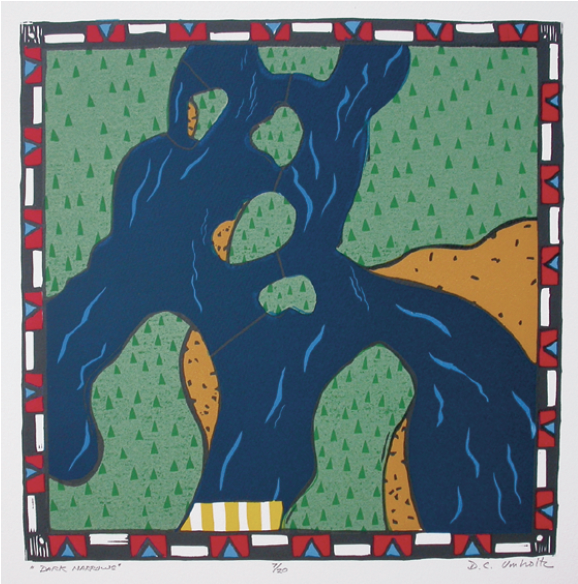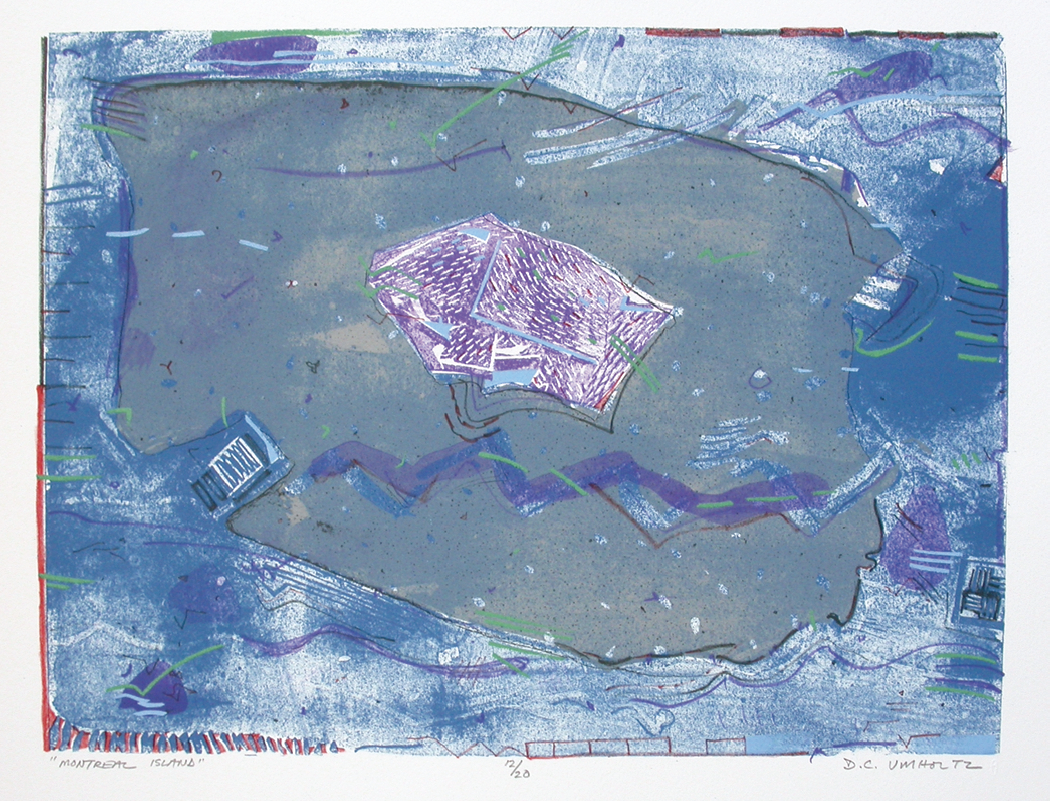David Umholtz
The exhibition entitled “Log of the Abenaki” by David Umholtz is unusual among art exhibitions these days in what might be described as “general” public venues for the visual arts. It is a solo show comprised entirely of prints. Perhaps there really is a resurgence of appreciation tor the laborious process that has been usurped by photomechanical reproductions that pass as numbered editions. Or, this may be a function of the location of the show in a Loyalist city that values traditional ways of doing things. Nonetheless, it is refreshing to see so many—36, to be exact-well-executed prints in various media, all in the same place. This exhibition includes work completed over a 20-year span, with over half being recent work. The works demonstrate Umholtz’s range of expertise as one of Canada’s master printers. He is equally adept at relief printing of linocuts and woodcuts, as well as lithography. There is also a smattering of collage monotypes. The prints in this exhibition are technically well executed and artistically innovative.
David Umholtz has been working as an artist for almost 40 years. He is one of the many mid-career “artists in waiting” in Canada who had his 15 minutes of fame early in his career and has been quietly creative ever since, exhibiting his work consistently in regional, national and international shows. His work ranges from the abstract to recognizable references. While there is a continuity in his work, both stylistically and thematically, there is no sense of repetitiveness—rather, of careful exploration of the detail of place. And “place” is the central theme of his work, with water and navigation playing a key role.

David Umholtz, La Rivière Qui Passe, 2003, linocut on paper, ed. 7/20, 21 × 20” paper, 14 x 13.5” image. Photographs courtesy Open Studio, Toronto.
The “cutting edge” in this exhibition is the combination of content and form. Neither landscapes nor maps, these works suggest place from a unique perspective.
There are several thematic suites in the show. The “Log of the Abenaki,” on which the show is titled, is a series of small, predominantly black and white woodcuts and linocuts. This is Umholtz’s ongoing, imagined visual record of the journey of the long-gone ferry named the Abenaki, which travelled the waters in the Bay of Fundy, where the artist makes his full-time residence. If we accept that history is socially constructed and that there is no one truth in narrative, these works become part of a record of travels. Several pieces from the “Archipelago Suite” are also in this exhibition. These are starkly simple, yet elegant, relief prints that map places we think we know. They take as their inspiration places in the maritime landscape that could be real, but are just enough removed from the familiar to lead to other interpretive possibilities. These works capture the in-between space of that which exists, that which might exist, or might have existed in another time.

David Umholtz, Dark Narrows, 2004, linocut on paper, ed. 7/20, 20 × 19 3/4” paper, 13 1/4 x 13 1/4” image.
Reflective of the day-to-day life in the Maritimes, the boundaries between land and water are transcended in this body of work. Water is an integral part of place in this part of the world, and capturing the complexity of that relationship is no easy task. For those who live here, the transition is seamless until something occurs to rupture it: a boating accident, the threat of a Liquid Natural Gas terminal, the collapse of the aquaculture industry. This work captures the seamlessness and hints at the ruptures.
Umholtz prints have both an intellectual and a visceral appeal. Intellectually, they are representations that capture landscape and human attempts to understand it as a picture of space. The cartographic style of the prints seems to represent our need to map place, but also points to the elusiveness of that task. We can, after all, never fully capture the essence of space in its shifting forms. Mapping is perspectival, even in this era of GPS devices that purport to settle the reality of space once and for all. The constant shifting of both place—however subtle—and viewer means that only one moment in time can be captured, and then only from the perspective of the narrator. Umholtz’s work gives the viewer a place to begin and, indeed, encourages the journey.

David Umholtz, Montreal Island, 2000, lithograph on paper, ed. 12/20, 16 1/4 × 20 1/2” paper, 12 1/2 x 16” image.
Viscerally, his work depicts an intimate knowledge of the familiar—places we live or have been. But the presentation is from a new vantage point, which makes it both familiar and strange at the same time with possibility, as well, for new insights, should the viewer care to take up the challenge.
In addition to this solo exhibition, Umholtz’s work is part of the group exhibition in celebration of the 30th anniversary of the St. Michael’s Print Shop, currently touring several locations across Canada. A number of his prints are also being shown in the Trois Rivières Print Biennale and his work has been included in the 2005 Boston Printmakers exhibition. ❚
“The Log of the Abenaki” is at the Saint John Arts Centre in Saint John, New Brunswick, from June 3 to June 30, 2005. The exhibition will travel to the Tides Institute, Eastport, Maine, from August until mid-September.
Lori Beaman is an Associate Professor of Sociology in the Department of Sociology and Anthropology at Concordia University.

